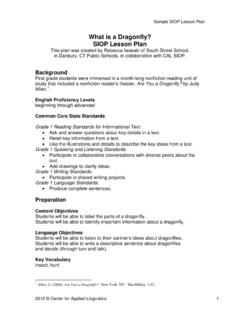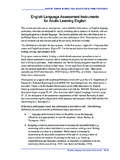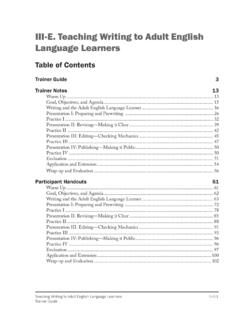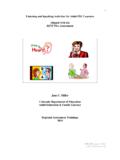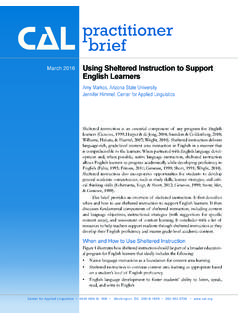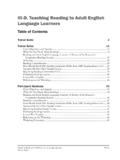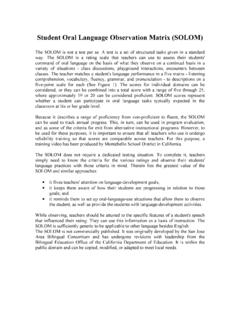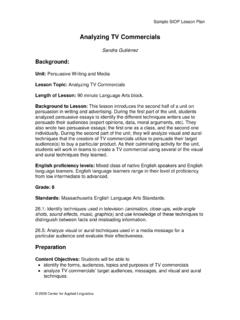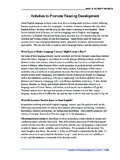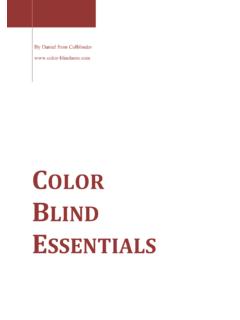Transcription of Healthy and Unhealthy Foods SIOP Lesson Plan
1 Sample siop Lesson plan 2010 @ Center for Applied Linguistics Healthy and Unhealthy Foods siop Lesson plan This plan was created by Courtney McGowan of Sugarland Elementary School in Sterling, VA as a part of the siop Lesson study project in collaboration with CAL. Background In previous lessons the students learned the names for common Foods and became familiar with the four food groups. Included in this study was a teacher-written, interactive poem about Foods the students like. English proficiency levels: beginning through advanced Grade: K Standards: State Health Standards of Learning, Grade K a -the importance of making Healthy food choices Preparation Content Objectives: The students will be able to identify Healthy and Unhealthy food .
2 Language Objectives: The students will be able to listen to a story and tell a buddy if a food is Healthy or Unhealthy . Key Vocabulary Healthy Unhealthy Materials Teacher Materials The Very Hungry Caterpillar by Eric Carle Smart Board presentation with Lesson objectives, food picture splash, and food sort Small posters with examples of Healthy and Unhealthy food Laminated pictures of Healthy and Unhealthy food (adapted from UVA s Book-a-Week Program ) Red- and green-labeled sort organizers Student Materials Laminated pictures of Healthy and Unhealthy food in plastic bags (adapted from UVA s Book-a-Week Program ) Red- and green-labeled sort organizers Suggested Differenti-ation strategies Vocabulary: For lower proficiency students, teacher may include other vocabulary items in addition to Healthy and Unhealthy .
3 Materials: Any additional items providing visual or verbal L1 support to lower proficiency students. Sample siop Lesson plan 2010 @ Center for Applied Linguistics Motivation Ask students about the Foods they have been learning about lately. Then ask them what kinds of Foods they like the best. Invite them to turn to a buddy and discuss their favorite Foods . Provide sentence starters or frames such as, My favorite Foods or I like _____the best. Then ask, What kinds of food do your parents want you to eat? Why?
4 Ask several students to share their answers with the class and elaborate, confirm, or correct as necessary. Explain that today we are going to learn about two types of food : Healthy and Unhealthy . Read and discuss the Lesson objectives with students. Presentation Using the Smart Board, engage students in a Picture Splash by showing the students large color pictures of Healthy and Unhealthy food . The Healthy food will be on one side of the screen, while the Unhealthy food is on the other side. Discuss and name the types of food .
5 Ask the students: Why do you think the food is separated into two groups? How are the Foods in each group different? What is the same about all of the food on the left? What is the same about all of the food on the right? Write students words and ideas on the Picture Splash and then tell students to turn to their buddy and answer the following question: Do you think it is better to eat more food from the group on the left or the group on the right? Why? Provide a sentence frame such as, I think the Foods from the left/right group are better Ask different pairs to share their ideas with the class.
6 Elaborate, confirm, or correct as necessary. As the discussion wraps up, ask students to guess what word best describes each group. Confirm that one side is Healthy and the other side is Unhealthy . The word Healthy is written in green, while Unhealthy is written in red. Define the words Healthy and Unhealthy : Healthy Foods are good for your body and they help you grow and become strong. Unhealthy Foods are bad for your body and they might give you a tummy ache or harm your teeth if you eat too much. Invite students to repeat the words Healthy and Unhealthy .
7 Model motions to go with each word and invite students to stand up and practice the motions. For the word Healthy , have students flex their arm muscles and for the word Unhealthy have them make a sick face and put their hands on their stomachs. Motivation: Provide sentence stems with visuals on note cards for less proficient students. The teacher can ask more proficient students to talk about their experiences, while the others listen and then share about their experiences in turn. Lower proficiency students can use L1 for their answers.
8 Presentation: For lower proficiency students, provide visuals and L1 translations for new words. Alternately, provide different lists of words to sort to each proficiency group. For asking questions: phrase questions in accordance with each group s proficiency level. Sample siop Lesson plan 2010 @ Center for Applied Linguistics Next read the book The Very Hungry Caterpillar by Eric Carle. Explain that they will be reading for a purpose. Tell students they will be looking and listening to see if the caterpillar eats Healthy or Unhealthy food .
9 Remind the students of the meanings of these words by asking them to perform the motions for Healthy and Unhealthy . Invite students to predict whether or not the caterpillar will eat Healthy or Unhealthy food . Why? Have students turn to a buddy and tell the buddy their prediction. Model the specific language to be used: I think that the caterpillar will eat Healthy / Unhealthy food Call on one or two students to share their buddy s prediction with the class. Post a small poster with the word Healthy written in green and pictures of Healthy Foods .
10 Post another small poster with the word Unhealthy written in red and pictures of Unhealthy Foods . Explain and model that when they see the caterpillar eating a Healthy food they will give a thumbs up and when they see him eating Unhealthy food they will give a thumbs down. Direct students to use the posters as a guide when making their choice about whether a food is Unhealthy or Healthy . After reading, ask students if the caterpillar ate more Healthy or Unhealthy food . Was our prediction correct? Have students turn to a buddy to answer the question.
